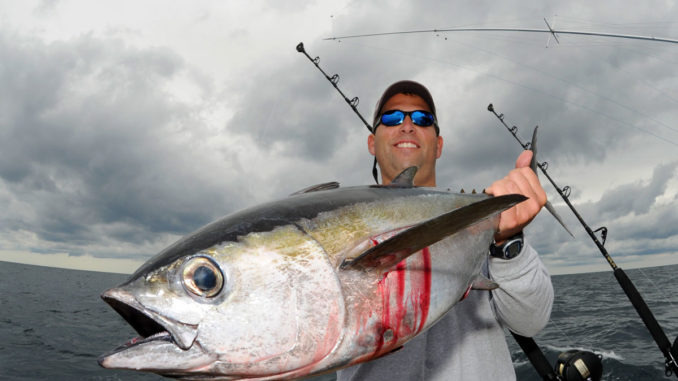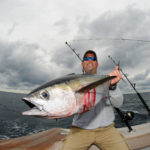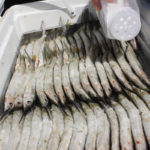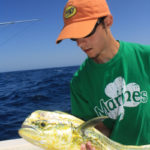
Offshore captains out of Morehead City, Atlantic Beach set bait spreads to target different species.
The seasonal rise in ocean temperature off the coastline of Atlantic Beach and Morehead City means the peak offshore fishing season has arrived at the Crystal Coast. These fertile waters feature some of the most-productive and diverse sportfishing in the country. During May and June each year, offshore waters burst with action.
“June is like prime time here,” said Capt. Thomas Wood of Dancin’ Outlaw Charters in Morehead City. “I’d put our fishing up against anybody’s in the world.”
As the warm waters of the Gulf Stream — which typically flow about 30 to 40 miles off the coast — move closer to shore, prized gamefish such as dolphin, sailfish, tuna, wahoo and marlin follow these fluctuating temperature patterns. Searching for these gamefish in a wide expanse of bluewater, veteran captains like Wood rely heavily on previous day’s experience as well as word-of-mouth reports. In lieu of any positive firsthand accounts there are always other ways of finding fish.
“If I had absolutely no information to go with from the day before, I would normally go to 30, 40 fathoms of water, maybe start somewhere around the Big Rock,” said Wood. “But every day is so different…. It changes by the hour.”
As a rule, offshore anglers will look for water temperatures ranging in the 70s. They also rely heavily on weather charts and satellite images, continually analyzing and searching for the slightest temperature changes that attract baitfish and predator fish.
“I don’t look for a specific temperature as much as I look for a temperature change,” said Wood. “As you get along in the summer, the changes become less and less evident. I use temperature gages a lot.”
Wood believes that the more temperature-sensing electronics he has onboard, the better his ability to detect even the most- minute temperature changes.
“When you get into June and July, when the water’s warmed up, the temperature out there only changes by measures in tenths of a degree,” he said. “All day, the temperature may only be a 1-degree, 2-degree variance, and you’re looking for tenths [of a degree] in changes. If you’ve got a change of temperature, there’s something going on there.”
When targeting these bluewater gamefish, most charter captains prefer trolling, which helps them cover a wide area of water. Variations in tackle and technique are based on personal preference and past results. Wood deploys a spread of) surface baits, primarily ballyhoo, and he runs them on very long lines. The baits he sets up in the wake use up about half a spool on a Tiagra 50 reel.
“A normal day of fishing this time of year, you can have your dolphin and wahoo spreads out and have one big bait out for blue marlin. And nine times out of 10, if the marlin comes into the spread, you can usually get him to focus on your big bait. So you can marlin fish and still catch a lot of other stuff at the same time, which is pretty cool.”
Wood typically uses Shimano Tiagra 30s, 50s, 80s and 130, but when a sailfish or a white marlin crashes the spread, he always has a pitch-back bait ready to go.
“We try to catch them on a PLD, a little Shimano [combo].Ideally, we try to match the fish with the tackle. We don’t always get it,” he laughed. “Sometimes you drop it back there, you think it’s a sailfish, and it turns out to be a 300-pound marlin. I’ve done that before. But catching a sail or a white on light tackle is a ball.”
Capt. Bill Williamson is a retired captain of the Fishn’ Warrior, a 33-foot Grady White 330 who, like Wood, believes that when it comes to offshore success, surface trolling with natural bait is the surest ticket to success.
“Most of these fish feed on the surface,” said Williamson, “and that’s where we pull the baits. We’ll put a little quarter-ounce chin weight on the rig so it will run from just under the surface, to just skipping on top. We troll anywhere from 6 to 7 ½ knots, and we try to fish temperature breaks, structure, grass lines and, of course, baitfish. That’s the most important thing, if we can find baitfish.”
Using primarily ballyhoo, Williamson runs seven or eight baits near the surface, using a spread of heavy conventional bait rods offset in an assortment of rod holders and outriggers, both inside and outside of the boat’s wake. The ballyhoo come from Florida, frozen and shipped north.
“I’ll get them prepared the day before,” said Williamson. “I thaw them out. Then I break their backs and get them (flexible enough) to where they look like they are swimming in the water.”
The baits are neatly positioned in a single layer on a bait tray and placed in a cooler over ice. Next, Williamson sprinkles kosher or brine salt or over the top of the baits to toughen them up so they don’t wash out or tear as easily. The next day, the baits are ready to be rigged and put into action.
As with all facets of fishing, there are always a number of ways to rig bait and tackle for the best results. As far as Williamson is concerned, simpler is better.
“Some people like to fish with big Ilanders and big chuggerbaits, but we normally try to go with as little as we can,” said Williamson, who will run baits with or without a sea witch or trolling feather in front of the bait. Using a rubber band and a pin rig, he runs the pin through the mouth of the ballyhoo, then loops a rubber band several times around the nose of the baitfish and the pin to secure it in place.
“Some people use a cone or a spring. Some people use wire,” he said, “but we’ve always had a lot of luck with rubber bands. It’s real easy to use and it just takes but a second to get the bait on the hook and back in the water.”
While the spread is targeting surface-feeding game fish such as dolphin, tuna, marlin and sailfish, Williamson likes to set up at least one additional line on a planer to troll deeper for wahoo.
“We’ll use a No. 16 Old Salty planer; it will get the bait down 30 or 40 feet,” he said. “We fish it on a bent-butt [Shimano] 80. The planer is on what we call an ‘in-line,’ so it’s on a bridle. When the fish hits, you reel it in until you get to the planer, the mate takes off the planer, and then you fight the fish on it.”
Covering multiple options within the water column like this increases the chances of success, especially when the surface bite is off.
“You know, (catching) three or four wahoo is a good day,” said Williamson. “Wahoo, they’re not a schooling fish, they congregate in what we call packs, three or four in a pack. And a good wahoo day is three or four. Maybe we’ll luck up on some black*fin tuna. They’re small, but they eat just like a yellowfin and make great sushi.
DESTINATION INFORMATION
HOW TO GET THERE/WHEN TO GO — The Morehead City/Atlantic Beach area is most easily accessed via US 70, which crosses North Carolina from west to east. US 17 is one route that brings people in from north or south, through New Bern. The offshore season for dolphin, tuna, wahoo and billfish heats up in May and June.
TACKLE/TECHNIQUES — Heavy trolling outfits used with outriggers for surface trolling or trolling with planers are common. Baits and lures include chuggers, Ilanders, cone rigs or sea witches rigged with ballyhoo.
FISHING INFO/GUIDES — Capt. Joe Shute, 800-868-0941, www.captjoes.com; Fin Hunter Sportfishing, 252-622-6108, www.moreheadcitysportfishingcharters.com. See also Guides and Charters in Classifieds.
ACCOMMODATIONS — Crystal Coast Tourism Authority Morehead City, 252-726-8148, www.crystalcoastnc.org; Carteret County Chamber of Commerce, Morehead City, 252-726-6350, www.nccoastchamber.com.
MAPS — Capt. Segull’s Nautical Charts, 888-473-4855, www.captainsegullcharts.com; Sealake Fishing; Guides, 800-411-0185, www.thegoodspots.com; Maps Unique, 910-458-9923, www.mapsunique.com.




Be the first to comment